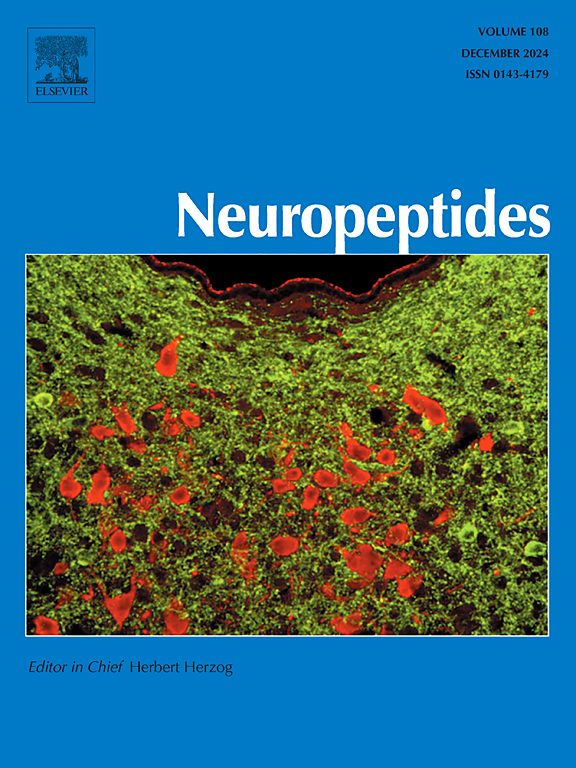鸢尾素可减轻SPS小鼠创伤后应激障碍的焦虑和恐惧消退缺陷
IF 2.7
3区 医学
Q3 ENDOCRINOLOGY & METABOLISM
引用次数: 0
摘要
创伤后应激障碍(PTSD)是一种普遍的心理障碍,发生在严重的创伤事件或连续的创伤事件之后。鸢尾素在海马和前额叶皮层等大脑区域表达,并通过AMPK通路抑制神经炎症,具有神经保护功能,证明其在治疗认知能力下降、抗抑郁作用和干预压力相关疾病方面的潜力。本研究旨在探讨鸢尾素对PTSD的潜在治疗作用,并探讨其作用机制。结果表明,SPS引起小鼠焦虑样行为和恐惧记忆消退缺陷。通过外源性鸢尾素处理,这些sps诱导的小鼠异常被逆转。然而,AMPK抑制剂消除了鸢尾素的保护作用,表明鸢尾素对SPS小鼠的治疗作用是通过激活AMPK来实现的。进一步的生化实验表明,鸢尾素可以提高SPS小鼠海马、额叶皮层和杏仁核中pAMPK水平,改善NF-κB及其下游因子(包括炎症因子和神经毒性介质)的过度表达。鸢尾素的这些作用也被AMPK抑制剂逆转。细胞实验表明,鸢尾素通过AMPK/NF-κB通路对BV2细胞(小胶质细胞)发挥抗炎作用,随后在增强PC12细胞活力的同时具有抗炎作用。综上所述,鸢尾素可通过发挥抗神经炎症功能改善SPS诱导的小鼠行为缺陷,该功能可能与海马、大脑皮层、杏仁核等脑组织小胶质细胞中AMPK/NF-κB通路的调节有关。本文章由计算机程序翻译,如有差异,请以英文原文为准。
Irisin alleviates anxiety and deficits in fear extinction in PTSD within SPS mouse model
Post-Traumatic Stress Disorder (PTSD), a prevalent psychological disorder, emerges subsequent to a grave traumatic incident or a succession of such events. Irisin is expressed in brain regions such as the hippocampus and prefrontal cortex and is found to have a neuroprotective function by suppressing neuroinflammation through the AMPK pathway, demonstrating its potential in treating cognitive decline, having antidepressant effects, and intervening in stress-related disorders. This study aims to explore the potential therapeutic effects of irisin on PTSD, as well as investigate the underlying mechanisms. Results showed that SPS caused anxiety-like behaviors and deficit in fear memory extinction of the mice. These SPS-induced abnormalities of the mice were reversed by exogenous irisin treatment. However, the AMPK inhibitor abolished the protective effects of irisin, indicating that irisin's therapeutic effects on SPS mice were achieved by activating AMPK. Further biochemical experiments demonstrated that irisin could increase pAMPK levels and ameliorate the overexpression of NF-κB and its downstream factors, including inflammatory factors and neurotoxic mediators, in the hippocampus, frontal cortex, and amygdala of the SPS mice. These effects of irisin were also reversed by AMPK inhibitor. Cell experiments suggest that irisin exerts anti-inflammatory effects on BV2 cells (microglia) via the AMPK/NF-κB pathway and subsequently confers anti-inflammatory benefits while enhancing cell viability in PC12 cells. The cumulative results indicate that irisin can improve behavioral deficits induced by SPS in mice by exerting anti-neuroinflammation function, and this function may be associated with the modulation of AMPK/NF-κB pathway in microglia in the brain tissues including hippocampus, cerebral cortex, and amygdala.
求助全文
通过发布文献求助,成功后即可免费获取论文全文。
去求助
来源期刊

Neuropeptides
医学-内分泌学与代谢
CiteScore
5.40
自引率
6.90%
发文量
55
审稿时长
>12 weeks
期刊介绍:
The aim of Neuropeptides is the rapid publication of original research and review articles, dealing with the structure, distribution, actions and functions of peptides in the central and peripheral nervous systems. The explosion of research activity in this field has led to the identification of numerous naturally occurring endogenous peptides which act as neurotransmitters, neuromodulators, or trophic factors, to mediate nervous system functions. Increasing numbers of non-peptide ligands of neuropeptide receptors have been developed, which act as agonists or antagonists in peptidergic systems.
The journal provides a unique opportunity of integrating the many disciplines involved in all neuropeptide research. The journal publishes articles on all aspects of the neuropeptide field, with particular emphasis on gene regulation of peptide expression, peptide receptor subtypes, transgenic and knockout mice with mutations in genes for neuropeptides and peptide receptors, neuroanatomy, physiology, behaviour, neurotrophic factors, preclinical drug evaluation, clinical studies, and clinical trials.
 求助内容:
求助内容: 应助结果提醒方式:
应助结果提醒方式:


